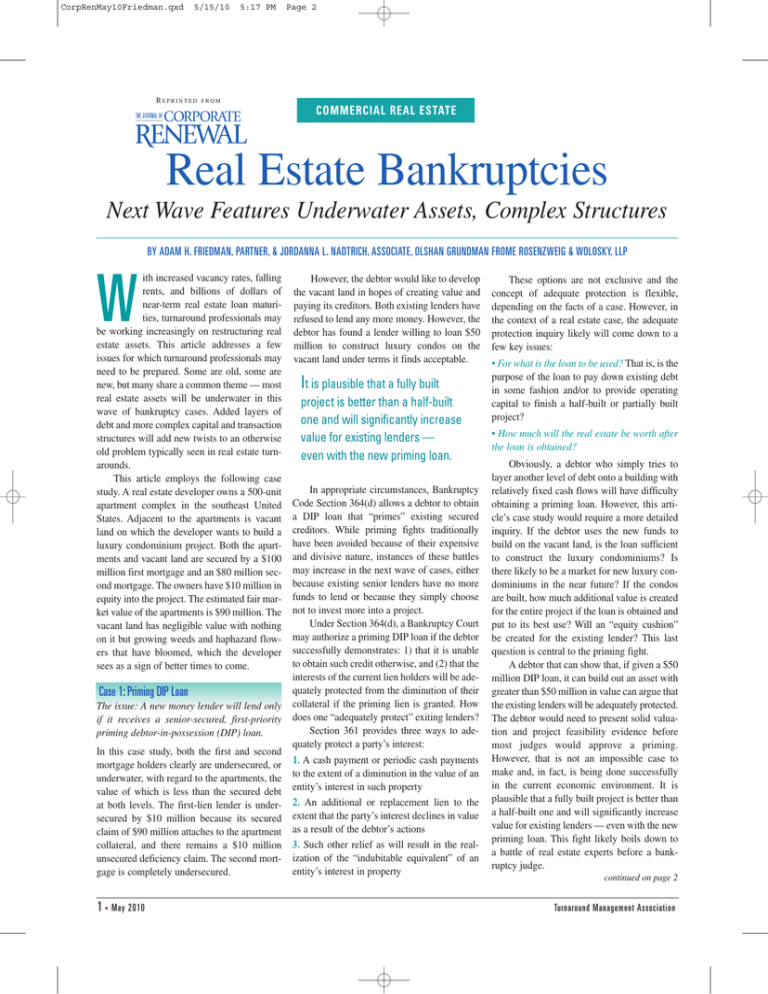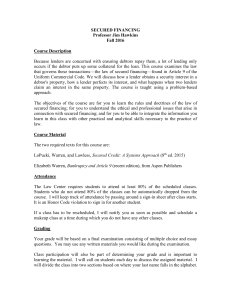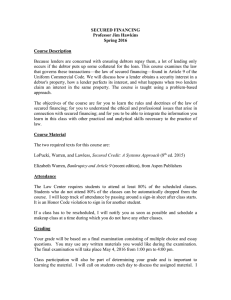
CorpRenMay10Friedman.qxd
5/15/10
REPRINTED
5:17 PM
Page 2
FROM
COMMERCIAL REAL ESTATE
Real Estate Bankruptcies
Next Wave Features Underwater Assets, Complex Structures
BY ADAM H. FRIEDMAN, PARTNER, & JORDANNA L. NADTRICH, ASSOCIATE, OLSHAN GRUNDMAN FROME ROSENZWEIG & WOLOSKY, LLP
ith increased vacancy rates, falling
rents, and billions of dollars of
near-term real estate loan maturities, turnaround professionals may
be working increasingly on restructuring real
estate assets. This article addresses a few
issues for which turnaround professionals may
need to be prepared. Some are old, some are
new, but many share a common theme — most
real estate assets will be underwater in this
wave of bankruptcy cases. Added layers of
debt and more complex capital and transaction
structures will add new twists to an otherwise
old problem typically seen in real estate turnarounds.
This article employs the following case
study. A real estate developer owns a 500-unit
apartment complex in the southeast United
States. Adjacent to the apartments is vacant
land on which the developer wants to build a
luxury condominium project. Both the apartments and vacant land are secured by a $100
million first mortgage and an $80 million second mortgage. The owners have $10 million in
equity into the project. The estimated fair market value of the apartments is $90 million. The
vacant land has negligible value with nothing
on it but growing weeds and haphazard flowers that have bloomed, which the developer
sees as a sign of better times to come.
W
Case 1: Priming DIP Loan
The issue: A new money lender will lend only
if it receives a senior-secured, first-priority
priming debtor-in-possession (DIP) loan.
In this case study, both the first and second
mortgage holders clearly are undersecured, or
underwater, with regard to the apartments, the
value of which is less than the secured debt
at both levels. The first-lien lender is undersecured by $10 million because its secured
claim of $90 million attaches to the apartment
collateral, and there remains a $10 million
unsecured deficiency claim. The second mortgage is completely undersecured.
1 • May 2010
However, the debtor would like to develop
the vacant land in hopes of creating value and
paying its creditors. Both existing lenders have
refused to lend any more money. However, the
debtor has found a lender willing to loan $50
million to construct luxury condos on the
vacant land under terms it finds acceptable.
It is plausible that a fully built
project is better than a half-built
one and will significantly increase
value for existing lenders —
even with the new priming loan.
In appropriate circumstances, Bankruptcy
Code Section 364(d) allows a debtor to obtain
a DIP loan that “primes” existing secured
creditors. While priming fights traditionally
have been avoided because of their expensive
and divisive nature, instances of these battles
may increase in the next wave of cases, either
because existing senior lenders have no more
funds to lend or because they simply choose
not to invest more into a project.
Under Section 364(d), a Bankruptcy Court
may authorize a priming DIP loan if the debtor
successfully demonstrates: 1) that it is unable
to obtain such credit otherwise, and (2) that the
interests of the current lien holders will be adequately protected from the diminution of their
collateral if the priming lien is granted. How
does one “adequately protect” exiting lenders?
Section 361 provides three ways to adequately protect a party’s interest:
1. A cash payment or periodic cash payments
to the extent of a diminution in the value of an
entity’s interest in such property
2. An additional or replacement lien to the
extent that the party’s interest declines in value
as a result of the debtor’s actions
3. Such other relief as will result in the realization of the “indubitable equivalent” of an
entity’s interest in property
These options are not exclusive and the
concept of adequate protection is flexible,
depending on the facts of a case. However, in
the context of a real estate case, the adequate
protection inquiry likely will come down to a
few key issues:
• For what is the loan to be used? That is, is the
purpose of the loan to pay down existing debt
in some fashion and/or to provide operating
capital to finish a half-built or partially built
project?
• How much will the real estate be worth after
the loan is obtained?
Obviously, a debtor who simply tries to
layer another level of debt onto a building with
relatively fixed cash flows will have difficulty
obtaining a priming loan. However, this article’s case study would require a more detailed
inquiry. If the debtor uses the new funds to
build on the vacant land, is the loan sufficient
to construct the luxury condominiums? Is
there likely to be a market for new luxury condominiums in the near future? If the condos
are built, how much additional value is created
for the entire project if the loan is obtained and
put to its best use? Will an “equity cushion”
be created for the existing lender? This last
question is central to the priming fight.
A debtor that can show that, if given a $50
million DIP loan, it can build out an asset with
greater than $50 million in value can argue that
the existing lenders will be adequately protected.
The debtor would need to present solid valuation and project feasibility evidence before
most judges would approve a priming.
However, that is not an impossible case to
make and, in fact, is being done successfully
in the current economic environment. It is
plausible that a fully built project is better than
a half-built one and will significantly increase
value for existing lenders — even with the new
priming loan. This fight likely boils down to
a battle of real estate experts before a bankruptcy judge.
continued on page 2
Turnaround Management Association
CorpRenMay10Friedman.qxd
5/15/10
5:17 PM
REAL ESTATE BANKRUPTCIES
continued from page 1
For example, in In re 495 Central Park
Avenue Corp., 136 B.R. 626 (Bankr. S.D.N.Y.
1992), the debtor sought to obtain financing
from a third party that would prime the secured
position of its first-lien lender. In determining
whether the existing first-lien lender was adequately protected by the priming loan, the
court said that it “must consider whether the
value of the debtor’s property will increase
as a result of the renovations funded by the
proposed financing.”
Although appraisers for the two sides
disagreed on what the value of the property
would be following the infusion of additional
funds, the court found that “there is no question that the property would be improved by
the proposed renovations and that an increase
in value will result. In effect, a substitution
occurs in that the money spent for improvements will be transferred into value. This
value will serve as adequate protection for [the
existing lender’s] secured claim.”
Another court from the same district has
observed that the “most important question…
is whether the interest of the secured creditor
whose lien is to be primed is being unjustifiably jeopardized.” In re Mosello, 195 B.R. 277,
289 (Bankr. S.D.N.Y. 1996). In this article’s
hypothetical case, a judge who concluded that
there is no market for newly built luxury
condos or that the existing lender’s collateral
position would be jeopardized by what the
judge perceived as a developer’s wishful
thinking would not approve the loan. Thus, the
“equity cushion” argument alone may not be
sufficient to win approval.
However, perhaps the hypothetical debtor’s
chances increase if it uses $20 million of its
DIP loan to fund a reserve to pay down the
senior lender and uses the balance to build the
condos. Or, perhaps the DIP lender agrees to a
less onerous waterfall of proceeds from
the sale of new units so that the exiting lenders
can be repaid through some portion of net sale
proceeds from the condo sales.
Priming is a powerful tool that exists only
in bankruptcy cases. Debtors may need to
explore this option either to finish projects or
as a negotiating tool to bring existing lenders
to the table.
2 • May 2010
Page 3
Case 2: Equity’s ‘New Value Plan’
The issue: How can creditors or other
investors protect themselves when an existing
owner tries to invest new value into a real
estate project to retain an ownership interest?
The absolute priority rule in Bankruptcy
Code Section 1129(b) provides that a plan of
reorganization cannot be confirmed over the
objection of a class of unsecured claims unless
the plan provides either of the following: a) all
members of the class are to receive or retain
property that has a value as of the effective date
of the plan equal to the allowed amount of their
claims, or b) no class of claims or interests that
is junior to the class will receive or retain any
property on account of their claims or interests.
Because the Supreme Court did not
offer guidance on how new value
equity auctions are to be properly
conducted, these concepts are ripe
for turnaround professionals to explore.
Because equity interests are junior to
claims held by unsecured creditors, equity cannot retain its ownership interests in a debtor,
absent the consent of unsecured creditors,
unless the unsecured creditors will receive
payment in full. There exists, however, an
exception to the absolute priority rule known
as the “new value” exception. It allows equity
holders to retain their ownership interests even
though creditors do not receive full payment
of their claims, provided that the new capital
contributed to the reorganized debtor is an
amount reasonably equivalent to the equity’s
retained interest in the debtor.
The new value plan is often the last refuge
of an owner seeking to retain ownership. The
equity holder agrees to contribute new value,
generally cash, to retain its equity in the reorganized debtor. It is generally conceded that
the new value exception requires that the
equity holders’ infusion of capital be:
1. Substantial
2. New
3. Reasonably equivalent to the interest being
retained
4. In the form of “money or money’s worth”
that constitutes more than a promise by the
equity holders to make future payments
5. Necessary to a reorganization
In 1999, the U.S. Supreme Court examined new value and held that a debtor’s pre-
bankruptcy equity holders may not, over the
objection of a senior class of impaired creditors, contribute new capital and receive ownership interests in the reorganized entity when
that opportunity is given exclusively to the old
equity holders under a plan adopted without
consideration of alternatives. See Bank of
America National Trust and Savings Association v. 203 N. LaSalle Street P.ship.
The Supreme Court held in that case that
new value offered exclusively to prepetition
owners violated the Bankruptcy Code’s
absolute priority rule. The court’s concern that
old equity might not be paying top dollar
for the equity interest that it retained or
received in the reorganized debtor was based
on old equity’s “exclusive opportunity” to buy
the equity. It was this exclusive opportunity
to buy (and to set the price) that was the “property” that was being received “on account of”
the former equity interest.
Accordingly, the court held that a new
value plan could be considered only when
either the right to buy the new equity was subject to a market test or open auction, or after
the termination of the exclusivity period —
during which only the debtor can propose a
plan — thereby effectively auctioning off the
underlying property by creating an opportunity
for creditors to propose their own plan of
reorganization. Proposed creditor plans often
provide for the property to be surrendered to
the secured creditors.
This raises several issues to consider:
• Assuming an equity owner decided to allow
its equity to be exposed to a market test, how
does a turnaround professional go about
doing this? Should the auction be held in connection with the plan confirmation hearing or
at some earlier point in time? Do bid procedure elements that are regularly employed in
Section 363 asset sales, such as marketing by
a banker, apply to equity sales?
• Can the secured creditor credit bid its claims?
(Some courts have said they cannot because
the secured creditor does not have a lien on
the equity of the reorganized debtor).
• While an invitation for competing bids may
appear to be in line with the Supreme Court’s
holding in 203 N. La Salle, creditors and
other parties in interest may contend that this
will actually chill the process because
management — which obviously will be
involved in the auction process — has a
strategic advantage.
continued on page 3
Turnaround Management Association
CorpRenMay10Friedman.qxd
5/15/10
5:17 PM
REAL ESTATE BANKRUPTCIES
continued from page 2
Because the Supreme Court did not offer
guidance on how new value equity auctions
are to be properly conducted, these concepts
are ripe for turnaround professionals to
explore.
Case 3: Bifurcating Lenders’ Claims
The issue: How do the lenders avoid being
wiped out if a debtor files a plan seeking to
bifurcate both lenders’ claims into secured
and unsecured deficiency claims, and how can
they preserve upside value in the future?
Bankruptcy Code Section 1111(b)
enables a secured creditor to avoid being
“stripped down” and treated as an undersecured secured creditor with a deficiency
claim. While this code section is complex and
much of it is beyond the scope of this article,
a powerful procedure this section contemplates is allowing a partially secured creditor
to elect to be treated as “fully secured.” A
Section 1111(b)(2) election may be an optimal option for a secured lender in the current
economic environment — when real estate
values are depressed but will likely appreciate.
Electing to be fully secured under Section
1111(b)(2) provides the potential to benefit
from upside appreciation of value, and it
avoids valuation disputes before a court.
For the hypothetical scenario, what if the
debtor files a Chapter 11 plan that treats the
senior lender as having an $80 million secured
claim and a $20 million unsecured deficiency
claim? The debtor would term out the secured
3 • May 2010
Page 4
portion over time at a market rate of interest
and would likely pay the unsecured deficiency
claim at pennies on the dollar. By making the
1111(b)(2) election, however, the first-lien
lender would have a $100 million secured
claim. Despite that, the debtor would be
required only to offer a payment stream equal
to at least the value of the holder’s “allowed
claim” — in this case, $80 million. As one
court observed, the payment stream need only
have a present value of at least the value of
the collateral.
Thus, while the payments would equal the
same amount of the non-electing creditors ($80
million in the hypothetical), the sum of the payments must be in an amount equal to
at least the secured creditors total claim, or
$100 million in the hypothetical. See Collier on
Bankruptcy 1111.03[4] (Alan N. Resnick &
Henry J. Sommer eds., 16th ed.) citing First
Fed. Of California v. Weinstein (In re Weinstein), 227 B.R. 284, 294 (B.A.P. 9th Cir 1998).
Consequently, an election under Section
1111(b)(2) allows a secured creditor to maintain its lien on its collateral, irrespective of
the valuation of the collateral at the time of
confirmation. In a depressed real estate market,
creditors should think hard about the Section
1111(b)(2) election to save upside value. It may
be
interesting
to
see
vastly
out-of-the-money second lien creditors make
such elections. That alone may force a debtor
to sell its assets to avoid the impact of such
an election.
There are a few issues and rules for lenders
to consider before making a Section 1111(b)(2)
election:
• In a multi-participant lender group, which is
common in many recent financings, the class
must make the election by voting half in number of creditors in the class and two-thirds in
amount of claims
• The election does not apply in a situation in
which a debtor sells its assets via a Section
363 sale or under the plan [see 1111(b)
(1)(A)(ii)]
• The electing undersecured creditor loses the
right to vote with regard to the previously
unsecured claim. This could impact whether a
plan is confirmable because in many cases, a
secured lender’s unsecured deficiency claim
gives it a significant blocking position in the
confirmation process.
• The election must be made before the conclusion of the hearing on the disclosure statement, unless the court extends the deadline
Issues Ahead
Turnaround professionals may be busy restructuring underwater real estate projects. Both old
and new techniques and issues will be tested,
and new strategies will be developed to confront problems inherent in half-built projects
and other projects that were financed during
the credit boom. CR
Adam H. Friedman is a
partner in the Business
Restructuring & Bankruptcy
Group at Olshan Grundman
Frome Rosenzweig &
Wolosky, LLP, in New York.
Jordanna L. Nadritch is an
associate in the firm’s Business
Restructuring & Bankruptcy Group.
This article is reprinted with permission of The
Journal of Corporate Renewal. All rights reserved.
Turnaround Management Association





